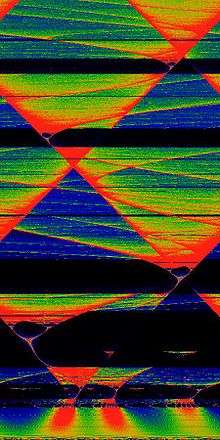Complex quadratic polynomial
A complex quadratic polynomial is a quadratic polynomial whose coefficients and variable are complex numbers.
Properties
Quadratic polynomials have the following properties, regardless of the form:
- It is an unicritical polynomial, i.e. it has one critical point,
- It can be postcritically finite, i.e. the orbit of the critical point can be finite, because the critical point is periodic or preperiodic.[1]
- It is a unimodal function,
- It is a rational function,
- It is an entire function.
Forms
When the quadratic polynomial has only one variable (univariate), one can distinguish its four main forms:
- The general form: where
- The factored form used for logistic map
- which has an indifferent fixed point with multiplier at the origin[2]
- The monic and centered form,
The monic and centered form has been studied extensively, and has the following properties:
- It is the simplest form of a nonlinear function with one coefficient (parameter),
- It is a centered polynomial (the sum of its critical points is zero).[3]
The lambda form is:
- the simplest non-trival perturbation of unperturbated system
- "the first family of dynamical systems in which explicit necessary and sufficient conditions are known for when a small divisor problem is stable"[4]
Conjugation
Between forms
Since is affine conjugate to the general form of the quadratic polynomial it is often used to study complex dynamics and to create images of Mandelbrot, Julia and Fatou sets.
When one wants change from to :[5]
When one wants change from to the parameter transformation is[6]
and the transformation between the variables in and is
With doubling map
There is semi-conjugacy between the dyadic transformation (the doubling map) and the quadratic polynomial case of c = –2.
Notation
Iteration
Here denotes the n-th iteration of the function (and not exponentiation of the function):
so
Because of the possible confusion with exponentiation, some authors write for the nth iterate of the function
Parameter
The monic and centered form can be marked by:
- the parameter
- the external angle of the ray that lands:
- at c in M on the parameter plane
- at z = c in J(f) on the dynamic plane
so :
Map
The monic and centered form, sometimes called the Douady-Hubbard family of quadratic polynomials,[7] is typically used with variable and parameter :
When it is used as an evolution function of the discrete nonlinear dynamical system
it is named the quadratic map:[8]
The Mandelbrot set is the set of values of the parameter c for which the initial condition z0 = 0 does not cause the iterates to diverge to infinity.
Critical items
Critical point
A critical point of is a point in the dynamical plane such that the derivative vanishes:
Since
implies
we see that the only (finite) critical point of is the point .
is an initial point for Mandelbrot set iteration.[9]
Critical value
A critical value of is the image of a critical point:
Since
we have
So the parameter is the critical value of
Critical orbit
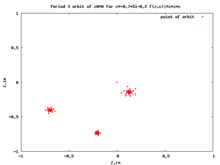
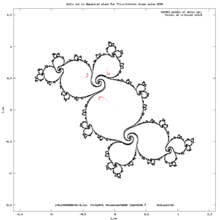


The forward orbit of a critical point is called a critical orbit. Critical orbits are very important because every attracting periodic orbit attracts a critical point, so studying the critical orbits helps us understand the dynamics in the Fatou set.[10][11][12]
This orbit falls into an attracting periodic cycle if one exists.
| Wikimedia Commons has media related to Category:Critical orbits. |
Critical sector
The critical sector is a sector of the dynamical plane containing the critical point.
Critical polynomial
so
These polynomials are used for:
- finding centers of these Mandelbrot set components of period n. Centers are roots of n-th critical polynomials
- finding roots of Mandelbrot set components of period n (local minimum of )
- Misiurewicz points
Critical curves
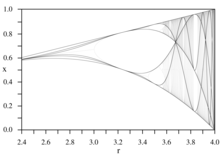
Diagrams of critical polynomials are called critical curves.[13]
These curves create the skeleton (the dark lines) of a bifurcation diagram.[14][15]
Spaces, planes
4D space
One can use the Julia-Mandelbrot 4-dimensional ( 4D) space for a global analysis of this dynamical system.[16]
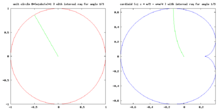
In this space there are 2 basic types of 2-D planes:
- the dynamical (dynamic) plane, -plane or c-plane
- the parameter plane or z-plane
There is also another plane used to analyze such dynamical systems w-plane:
2D Parameter plane


The phase space of a quadratic map is called its parameter plane. Here:
is constant and is variable.
There is no dynamics here. It is only a set of parameter values. There are no orbits on the parameter plane.
The parameter plane consists of:
- The Mandelbrot set
- The bifurcation locus = boundary of Mandelbrot set with
- root points
- Bounded hyperbolic components of the Mandelbrot set = interior of Mandelbrot set[19] with internal rays
- The bifurcation locus = boundary of Mandelbrot set with
- exterior of Mandelbrot set with
- external rays
- equipotential lines
There are many different subtypes of the parameter plane.[20][21]
See also :
- Boettcher map which maps exterior of mandelbrot set to the exterior of unit disc
- multiplier map which maps interior of hyperbolic component of Mandelbrot set to the interior of unit disc
2D Dynamical plane
"The polynomial Pc maps each dynamical ray to another ray doubling the angle (which we measure in full turns, i.e. 0 = 1 = 2π rad = 360◦), and the dynamical rays of any polynomial “look like straight rays” near infinity. This allows us to study the Mandelbrot and Julia sets combinatorially, replacing the dynamical plane by the unit circle, rays by angles, and the quadratic polynomial by the doubling modulo one map." Virpi K a u k o[22]
On the dynamical plane one can find:
- The Julia set
- The Filled Julia set
- The Fatou set
- Orbits
The dynamical plane consists of:
- Fatou set
- Julia set
Here, is a constant and is a variable.
The two-dimensional dynamical plane can be treated as a Poincaré cross-section of three-dimensional space of continuous dynamical system.[23][24]
Dynamical z-planes can be divided in two groups :
- plane for ( see complex squaring map )
- planes ( all other planes for )
Derivatives
First derivative with respect to c
On the parameter plane:
- is a variable
- is constant
The first derivative of with respect to c is
This derivative can be found by iteration starting with
and then replacing at every consecutive step
This can easily be verified by using the chain rule for the derivative.
This derivative is used in the distance estimation method for drawing a Mandelbrot set.
First derivative with respect to z
On the dynamical plane:
- is a variable;
- is a constant.
At a fixed point
At a periodic point z0 of period p the first derivative of a function
is often represented by and referred to as the multiplier or the Lyapunov characteristic number. Its logarithm is known as the Lyapunov exponent. It used to check the stability of periodic (also fixed) points.
At a nonperiodic point, the derivative, denoted by can be found by iteration starting with
and then using
This derivative is used for computing the external distance to the Julia set.
See also
References
- Alfredo Poirier : On Post Critically Finite Polynomials Part One: Critical Portraits
- Michael Yampolsky, Saeed Zakeri : Mating Siegel quadratic polynomials.
- Bodil Branner: Holomorphic dynamical systems in the complex plane. Mat-Report No 1996-42. Technical University of Denmark
- Dynamical Systems and Small Divisors, Editors: Stefano Marmi, Jean-Christophe Yoccoz, page 46
- Michael Yampolsky, Saeed Zakeri : Mating Siegel quadratic polynomials.
- stackexchange questions : Show that the familiar logistic map ...
- Yunping Jing : Local connectivity of the Mandelbrot set at certain infinitely renormalizable points Complex Dynamics and Related Topics, New Studies in Advanced Mathematics, 2004, The International Press, 236-264
- Weisstein, Eric W. "Quadratic Map." From MathWorld--A Wolfram Web Resource
- Java program by Dieter Röß showing result of changing initial point of Mandelbrot iterations Archived 26 April 2012 at the Wayback Machine
- M. Romera Archived 22 June 2008 at the Wayback Machine, G. Pastor Archived 1 May 2008 at the Wayback Machine, and F. Montoya : Multifurcations in nonhyperbolic fixed points of the Mandelbrot map. Archived 11 December 2009 at the Wayback Machine Fractalia Archived 19 September 2008 at the Wayback Machine 6, No. 21, 10-12 (1997)
- Burns A M : Plotting the Escape: An Animation of Parabolic Bifurcations in the Mandelbrot Set. Mathematics Magazine, Vol. 75, No. 2 (Apr., 2002), pp. 104-116
- Khan Academy : Mandelbrot Spirals 2
- The Road to Chaos is Filled with Polynomial Curves by Richard D. Neidinger and R. John Annen III. American Mathematical Monthly, Vol. 103, No. 8, October 1996, pp. 640-653
- Hao, Bailin (1989). Elementary Symbolic Dynamics and Chaos in Dissipative Systems. World Scientific. ISBN 9971-5-0682-3. Archived from the original on 5 December 2009. Retrieved 2 December 2009.
- M. Romera, G. Pastor and F. Montoya, "Misiurewicz points in one-dimensional quadratic maps", Physica A, 232 (1996), 517-535. Preprint Archived 2 October 2006 at the Wayback Machine
- Julia-Mandelbrot Space at Mu-ENCY (the Encyclopedia of the Mandelbrot Set) by Robert Munafo
- Carleson, Lennart, Gamelin, Theodore W.: Complex Dynamics Series: Universitext, Subseries: Universitext: Tracts in Mathematics, 1st ed. 1993. Corr. 2nd printing, 1996, IX, 192 p. 28 illus., ISBN 978-0-387-97942-7
- Holomorphic motions and puzzels by P Roesch
- Lasse Rempe, Dierk Schleicher : Bifurcation Loci of Exponential Maps and Quadratic Polynomials: Local Connectivity, Triviality of Fibers, and Density of Hyperbolicity
- Alternate Parameter Planes by David E. Joyce
- exponentialmap by Robert Munafo
- Trees of visible components in the Mandelbrot set by Virpi K a u k o , FUNDAM E N TA MATHEMATICAE 164 (2000)
- Mandelbrot set by Saratov group of theoretical nonlinear dynamics
- Moehlis, Kresimir Josic, Eric T. Shea-Brown (2006) Periodic orbit. Scholarpedia,
- The Schwarzian Derivative & the Critical Orbit by Wes McKinney 18.091 20 April 2005
External links
- Monica Nevins and Thomas D. Rogers, "Quadratic maps as dynamical systems on the p-adic numbers"
- Wolf Jung : Homeomorphisms on Edges of the Mandelbrot Set. Ph.D. thesis of 2002
| Wikimedia Commons has media related to Category:Complex quadratic map. |

